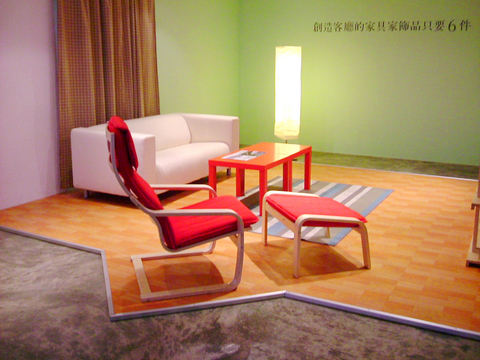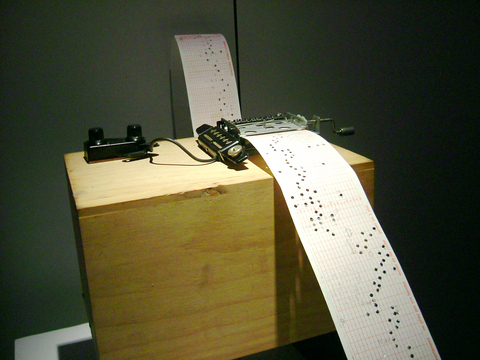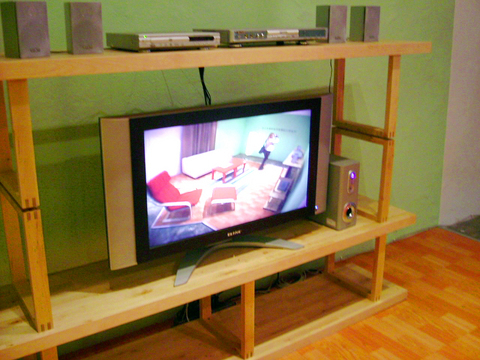Strolling around the furniture store IKEA is a fascinating experience for conceptual artist Tu Wei (杜偉) who currently has a solo exhibition titled Do Not Forget the Person in the Shade at IT Park.
The title refers to a style of photography made popular in the 1930s in Taiwan where a family had their group photo taken and wrote similar words under each person's image. As a catalog image sparks one's imagination, so does the archival past of memory and here Tu Wei tries to connect the universal world with the personal one.
The exhibition which looks deceptively similar to an IKEA living room display in that the two floors of the gallery have a parquet floor, a white sofa, a red lounge chair, a coffee table and a home entertainment system that are stand-ins.

PHOTOS: SUSAN KENDZULAK
Even though you are looking at something that resembles a product, you are not looking at IKEA per se. You are looking at a conceptual artwork that mimics how a public consumer showroom becomes a private individual platform for fantasy.
Tu Wei says that art allows us to imagine: much like dreaming of a new lifestyle in a furniture store. To hone the point further, the viewer's image is projected in a slow dissolve on the huge flat screen TV.
Conceptual art is definitely not WYSIWYG (what you see is what you get). It is more like doing mental calisthenics as the artist's metaphors may not be so obviously apparent on the surface. Another exhibition currently on view and which requires some thinking on the part of the viewer is Eric Lin Chi-wei's (

In the first room there are horizontal, faded framed scrolls that seem to contain some ancient writing, while in fact they are yellowed rolls of aged fax paper of musical notation.
Lin ran his sketches through the fax machine which read the images creating sound signals which he then recorded on tape and transferred again into the fax machine. Here Lin combined sound and image in a loop format.
On one wall, a long ribbon of hand-sewn characters becomes a prop for a group-chanting session, as the ribbon is passed from person to person while each one chants the character.

Additionally, there are some videos and taped recordings of some of Lin's avant-garde sound performances. In one, with a stocking pulled over his head, and donning a cardboard hand-painted tribal mask, Lin literally tries to shock the audience out of their seats.
The Chi-Wen Gallery will be one of the 40 participating international galleries at the Digital and Video Art Fair in New York on March 9 to March 12, that takes place in the Embassy Suites Hotel in lower Manhattan.
It is the first art fair in the world devoted to showing digital and video art. Due to its success last year, DiVa also exhibited in Brussels, Paris and Cologne.
For your information:
What: Eric Lin Chi-wei's `An Exposition of Unbelievable Hard-core Noises: Karma in Pause Mode'
Where: Chi-Wen Gallery (formerly known as Taipei MOMA), 3F, 19, Ln 252, Dunhua S Rd, Sec 1, Taipei
Telephone: (02) 8771 3372
When: Tue to Sat, 11am to 7pm, to Mar 18
What: Tu Wei's `Do Not Forget the Person in the Shade'
Where: IT Park, 2/3F, 41, Yitong St, Taipei (
Telephone: (02) 2507 7243
When: Tue. to Sat., 1pm to 10, pm to Mar 11

May 18 to May 24 Pastor Yang Hsu’s (楊煦) congregation was shocked upon seeing the land he chose to build his orphanage. It was surrounded by mountains on three sides, and the only way to access it was to cross a river by foot. The soil was poor due to runoff, and large rocks strewn across the plot prevented much from growing. In addition, there was no running water or electricity. But it was all Yang could afford. He and his Indigenous Atayal wife Lin Feng-ying (林鳳英) had already been caring for 24 orphans in their home, and they were in

President William Lai (賴清德) yesterday delivered an address marking the first anniversary of his presidency. In the speech, Lai affirmed Taiwan’s global role in technology, trade and security. He announced economic and national security initiatives, and emphasized democratic values and cross-party cooperation. The following is the full text of his speech: Yesterday, outside of Beida Elementary School in New Taipei City’s Sanxia District (三峽), there was a major traffic accident that, sadly, claimed several lives and resulted in multiple injuries. The Executive Yuan immediately formed a task force, and last night I personally visited the victims in hospital. Central government agencies and the

Australia’s ABC last week published a piece on the recall campaign. The article emphasized the divisions in Taiwanese society and blamed the recall for worsening them. It quotes a supporter of the Taiwan People’s Party (TPP) as saying “I’m 43 years old, born and raised here, and I’ve never seen the country this divided in my entire life.” Apparently, as an adult, she slept through the post-election violence in 2000 and 2004 by the Chinese Nationalist Party (KMT), the veiled coup threats by the military when Chen Shui-bian (陳水扁) became president, the 2006 Red Shirt protests against him ginned up by

As with most of northern Thailand’s Chinese Nationalist Party (KMT) settlements, the village of Arunothai was only given a Thai name once the Thai government began in the 1970s to assert control over the border region and initiate a decades-long process of political integration. The village’s original name, bestowed by its Yunnanese founders when they first settled the valley in the late 1960s, was a Chinese name, Dagudi (大谷地), which literally translates as “a place for threshing rice.” At that time, these village founders did not know how permanent their settlement would be. Most of Arunothai’s first generation were soldiers